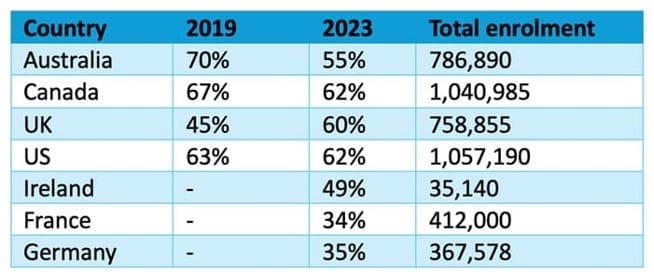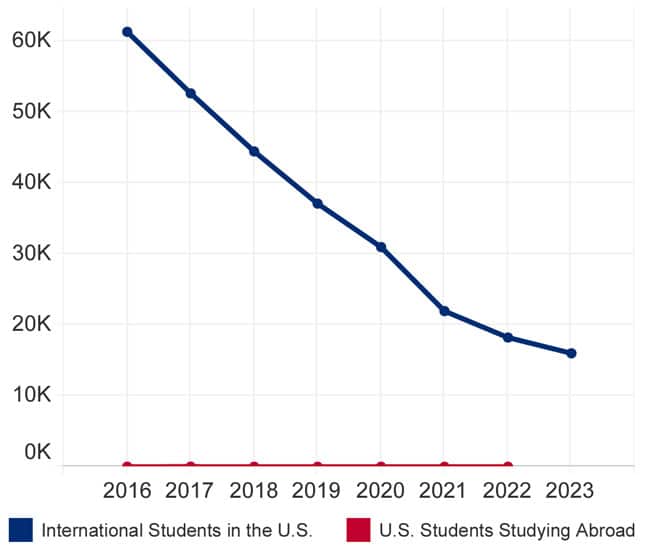New whitepaper urges US institutions to diversify foreign enrolment
- A new analysis from Oxford International Education Group underlines the need for US institutions to diversify their international student markets more – as soon as possible
- Not doing so exposes institutions to the risk of top markets evaporating due to geo-political, economic, or other factors
- In addition, domestic enrolments in US universities are projected to decline, beginning as soon as 2025
- Oxford suggests strategies both for recruiting international students from a wider range of countries and for supporting them once they have arrived
A new whitepaper from Oxford International Education Group, A Lack of Diversity Spells Adversity, highlights why it is so urgent for US institutions to commit more meaningfully and strategically to more global representation on their campuses. In 2023, China, India, South Korea, Canada, and Vietnam accounted for 62% of all international students enrolled in US colleges and universities.
Diversification progress of late
In August 2024, ICEF Monitor looked in on the extent to which major destinations have diversified their international student bodies and found that the US, along with Canada, is more dependent on top five sending markets than Australia, France, Germany, Ireland, and the UK. What’s more, unlike Australia and Canada, the US has not significantly reduced its reliance on top markets since 2019.

This status quo underlines the timeliness of the Oxford whitepaper, and the relevance of its focus on student motivations in emerging markets including Nigeria, Pakistan, and Vietnam.
Take nothing for granted
The whitepaper reminds us of the inherent volatility of student mobility flows with two examples: the discontinuation of the Brazil Scientific Mobility Program (BSMP) in 2017 and, even more dramatically, the phasing out of Saudi Arabia’s King Abdullah Scholarship Program (KASP) in 2015. The latter development has been a factor in Saudi enrolments in US institutions dropping from over 61,000 in 2015/16 to under 16,000 in 2022/23, as shown in the chart below from the Institute of International Education (IIE).

In the span of one year – 2015/16 to 2016/17 – Saudi enrolments fell by over 15%. Saudi Arabia is now the US’s tenth largest international student market; it had been third before the winding down of the KASP beginning in 2015.
China, too, is a source of concern. Long the US’s number one sending market, China accounted for 27% of the total international student population in the US in 2022/23 – down from 35% in 2019/20. We expect to see China replaced by India as the top market in the next round of IIE reporting.
Domestic enrolment cliff approaching
The Oxford whitepaper says that another imminent danger for US institutions is that demographic trends are leading to a projected drop in the number of American high-school graduates as soon as 2025. This means the pool of domestic prospects for colleges and universities will shrink – and at the same time as more young Americans are questioning the value of a degree. A diversified flow of international students into the US will be essential to mitigate the decline in domestic student numbers.
International students needed for balance
In 2023, the US Supreme Court ruled to significantly limit universities’ consideration of students’ race in admissions decisions. This has made it more difficult for institutions to meet diversity and inclusion goals. The whitepaper elaborates:
“Relatedly, recent political and policy shifts at the U.S. state level have increased scrutiny and, in some cases, rolled back DEI programming and initiatives, particularly in public secondary and postsecondary institutions.”
In this context, recruiting international students from a wide variety of countries can help to keep campuses vibrant with a multitude of ethnicities, religions, and experiences represented.
Five key takeaways
The case for expanding geographic focus in international student recruiting is clear, but the Oxford whitepaper rightly points out that recruitment is just part of any successful diversification initiative. Hosting international students properly is another: “Ensuring [international students’] well-being is central to their retention and success.”
With that in mind, the whitepaper offers five key takeaways* that include not only strategies for attracting a diversity of international students, but also ideas for how to serve international students once they are enrolled.
*The takeaways reflect direct wording from the Oxford paper, paraphrasing, and editing for brevity. We recommend reading the paper in its entirety for elaboration.
1. Align international student strategy with diversity efforts. This includes:
- Admissions processes that consider a wide range of criteria beyond academic performance;
- Scholarships and financial aid specifically targeted at international students from underrepresented regions and socio-economic backgrounds;
- Formal mechanisms for gathering and analysing current international student feedback about their experience and challenges.
2. Leverage technology and digital engagement. This includes:
- More leveraging of digital tours, virtual reality, and webinars to attract prospective students who cannot travel for in-campus visits;
- Robust social media channels where prospective and current students can interact;
- Online programmes that allow international students to begin part (or all) of their degrees in their home country.
3. Foster diversity by creating an inclusive environment for international students. This includes:
- Organising cultural events and programmes that celebrate diversity and promote cross-cultural interaction;
- Establishing international student associations, mentorship programmes, and peer support groups where international students can share their experiences, seek advice, and receive emotional support;
- Training for faculty and staff that focuses on cultural sensitivity, creating culturally diverse curricula, and promoting intercultural exchange programmes.”
4. Enhance support services for a diverse international student body. This includes:
- Comprehensive orientation programmes tailored specifically for international students that cover academic expectations, campus resources, and cultural norms in the US, helping students from various regions feel welcomed and prepared;
- Specialised advising and counselling services based on an understanding of the unique challenges faced by students from different cultural backgrounds and covering course selection, career planning, and academic regulations;
- Knowledge of the diverse motivations of international students, which facilitates the design of programmes and services that align with students’ goals, such as offering career development workshops, cross-cultural exchange opportunities, and language support services.
5. Strengthening partnerships with global institutions and school systems. This includes:
- Collaborating with global institutions, including student exchanges, joint research projects, scholarship programmes, and collaborative research projects with institutions in Global South countries. “These research projects can address critical global challenges and enhance the institution’s reputation as a leader in international education.”
- Engaging with high schools in key source countries to increase their visibility to potential undergraduate international students.
Practical considerations
The whitepaper does not gloss over the fact that a real commitment to diversification is not always easy. Challenges include aligning institutional budgets with diversification goals (often in a context where budgets are already tight and resources scarce) and restrictive immigration policies that include relatively high visa refusal rates for applicants from the Global South. Regarding the immigration hurdle, the paper says:
“These barriers will have to be addressed by active advocacy on the parts of institutions who are eager to admit and enroll a more diverse international student body but are limited by restrictive immigration policies.”
Read more
The whitepaper includes deep dives into trends in key emerging target markets as well as case studies. The full report is available here.
For additional background, please see:
- Attend ICEF USA, a specially curated event that takes place immediately following the NAFSA 2025 Annual Conference and enables North American educators to meet with top ICEF accredited education agencies from around the world.
- “How diverse is the international student population in leading study destinations”
- “Report calls for a more diverse foreign enrolment in the UK”
















